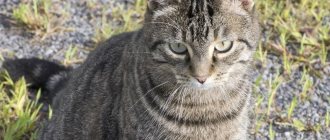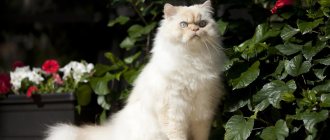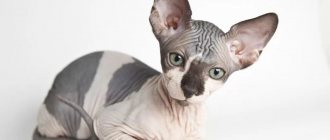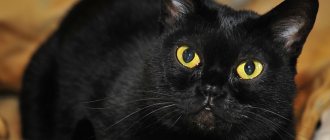When hearing the word “bobtail,” many people associate it with a dog. We tend to think that this is the name of the breed, although this term is used to refer to bobtail. And not only dogs, but also cats have this body structure. In any case, the Japanese Bobtail is one of the famous cat breeds, the representatives of which are distinguished by a short tail.
These cute creatures came to us from distant Japan and today live in the homes of many cat lovers. Easy care and playful character are advantages that any owner will definitely appreciate.
Origin story
The first information about the breed can be found in Japanese sources. But since Japan is an island nation that has been isolated for a long time, it is difficult to trace the historical path of cats as reliably as possible. However, it is known that people first started talking about the breed in 530-540. ad. This is how cats came to Japan from ships that were engaged in trade. Most likely, these were Asian merchants, since the country was actively trading with China and Macau at that time.
The Japanese were afraid of ordinary cats with normal tails and for a long time did not dare to have them in their homes. They believed that there was an evil force in the animal's tail. Therefore, in the XIX-XX centuries. Cats born in Japan went to local surgeons, who cut off these appendages, believing that this way they could get rid of evil. It is believed that this physical abuse caused a gene mutation, and the animals were immediately born tailless.
But everything changed during the reign of Emperor Ichijo. He brought a Japanese bobtail into his palace - the cat received the status of a maid of honor and even wore a beautiful collar. Then the Japanese also decided to tame such cats. By the way, it is believed that bobtails used to have tails, although not as long as other breeds.
Until the middle of the 19th century. Japan was in political isolation, which is why the bobtail did not reach other countries. But when the country opened its borders, short-tailed pets aroused considerable interest from foreigners. In 1968, one of the breeders, Elizabeth Freret, brought the first representative of this breed to Western Asia, and then American Lynn Beck brought the kittens to the USA and founded a club dedicated to the breed.
In 1990, the Japanese Bobtail was officially recognized by breed and show associations around the world.
History of the breed
The breed has a long history: the first images of a cat with a pompom-shaped tail date back to the first century AD. We are talking about the paintings on the walls of the Gotokuji Temple in Tokyo. By the way, the famous figurines of a cat with a raised paw, which is believed to bring good luck, are traditionally depicted with a small tail, which means it is none other than a Japanese bobtail.
The Japanese Bobtail is depicted in many old oriental prints.
According to legend, the breed appeared due to the fact that their tails were specially cut off to prevent them from turning into monsters. In fact, with artificial amputation of the tail vertebrae, the genetic anomaly cannot be fixed; it can only be a natural mutation. Most likely, cats born with the shortest tail received some advantages in the struggle for survival (it was harder for enemies to catch and kill them), as a result, short-tailed individuals more actively interbred with each other, which contributed to the consolidation of the Jb allele gene.
Maneki-neko is a traditional figurine, also known as the "Money Cat" or "Luck Cat", depicting a Japanese Bobtail
Until the 1960s, Japanese bobtails were found only in the Land of the Rising Sun. Single individuals, of course, were exported to Europe and the USA, but they were not engaged in special breeding. It was only in 1968 that the first non-Japanese cattery for cats of this breed was formed - its founder was the American Elizabeth Frere. The first CFA breed standard was approved in 1971. The FIFe officially recognized the Japanese Bobtail in 1990.
By the way, initially American and European associations recognized only shorthaired Japanese bobtails. Long-haired individuals were rejected and not allowed to exhibit. Fluffy short-tailed cats were officially recognized only in 1993.
Description of the Japanese Bobtail: standard, characteristics
According to international standards, a purebred kitten must have the following characteristics:
- the average weight of an adult is 2.5-3 kg (cat) and 4-5 kg (cat);
- the head is long, slightly similar in shape to a triangle with equal sides, the muzzle is rounded at the bottom;
- large eyes, wary gaze;
- the eyes are located slightly at an angle;
- wide set of ears that stand straight, turned closer to the center of the head;
- long and slender body with clear geometry and a straight back;
- a long and even nose with two parallel stripes from the tip to the eyebrows;
- the paws are high and proportional, the front ones are shorter than the hind ones, but are located at an angle in the shape of the letter Z;
- The bobtail's tail can be curved, straight, pom-pom-like, or curled, but the difference between the Japanese bobtail is that it is very short;
- maximum tail length – 12 cm;
- The coat is of medium length, slightly thicker in the tail area, and there is no undercoat.
This description is typical for purebred cats. There are mixed species, and it is important to exclude them when choosing if in the future you plan to send the animal to an exhibition or organize a nursery.
Education and training
High intelligence allows you to teach cats several tricks, but at this moment they must be in a good mood. The main thing is to captivate the fluffy beauty, and then there will be no difficulties with training.
If desired, cats can be trained:
- stand on your hind legs;
- bring toys;
- jump over a barrier or hoop.
Important! Walks with your pet take place on a harness - he must be familiar with it in advance. If the “decoration” is refused, the animal is cajoled, a leash is put on for several minutes, gradually increasing the time.
Bobtail kitten is cheerful and active
Coloring Features
The Japanese Bobtail is distinguished by a faded color compared to the same Thai Bobtail, which has a contrasting coat. But cats of bright colors are also found in this breed, although less often. They are considered the most valuable. There are several color options:
- tricolor or mi-kay;
- fiery red;
- snow-white;
- black.
The eyes of a cat most often have a slight yellow tint, while in an animal with a white color they are blue. But sometimes animals are born with different colored eyes. This is especially true for snow-white kittens.
This variety is always worth higher than the standard options, because such an individual will always produce kittens with different eyes.
Colors
The Japanese Bobtail is characterized by any colors and eye colors. But for breeding work, a harmonious combination of colors is better. The most common colors are distinguished by elements of fiery red color with white spots. In addition, the white bobtail often carries the gene for different eyes - blue and golden. For a long time it was believed that only females were tortoiseshell, but recently it was discovered that males can also have this color, but they are sterile.
How much does a Japanese Bobtail cost?
- The price in Russia is from 15,000 to 35,000 rubles.
- The price in Ukraine is from 4,000 to 10,000 hryvnia.
If you want to buy a Japanese Bobtail kitten, it is best to contact experienced breeders and professional nurseries that guarantee its purebred, good upbringing and health.
Character
The Japanese Bobtail, like a true samurai, has an explosive and warlike character. Such cats are good hunters and are ready to hunt down small rodents, birds, and insects for hours. They constantly demand attention and try to move more often. They definitely need daily walks and games.
It is important to immediately train bobtails strictly, because they quickly acquire bad habits and are difficult to get rid of them. But they have friendly relations with family members. Children especially love bobtails, and they reciprocate. However, household members may be allergic to wool - it is important to rule out this fact before purchasing an animal.
If there are other pets in the house, it is important that they do not have the same explosive temperament. For example, it is difficult for a bobtail and a ferret to get along. They either quarrel or create a “gang” and act out in the absence of their owners. They do not like to sit on laps and do not tolerate being held in arms, because these creatures are independent and do not like it when their freedom is encroached upon.
Bobtails are inquisitive and easy to train. Therefore, it is important to immediately instill in them norms of behavior that will not interfere with the comfortable life of the owners. Also, from excess energy, a cat can scratch the wallpaper or tear a pillow to shreds. To avoid this, you need to pay attention to the animal - it does not like to be alone.
Characteristics of the bobtail breed
Japanese Bobtails are very intelligent creatures that do not create much noise or trouble. Perhaps this is how their distant ancestors spent time in the palaces of the imperial dynasty of Japan. But the modern cat is also distinguished by good behavior and a friendly disposition, and is excellent for keeping at home. They will find a common language with children and even dogs.
The pet quickly becomes attached to its owner and strives to win his attention with affection and devotion. He happily follows his owner relentlessly, climbing into his arms at the right moment. But if a person does not have time, the animal will understand this and will not impose itself.
The owner of this cat will experience frequent purring because it is a very talkative breed. Her vocal abilities are quite extensive. She can meow quietly and make loud sounds; loves to communicate with others this way.
The Japanese Bobtail is an active pet. It seems that his reserve of strength is inexhaustible. He can play and run around the house tirelessly. Developed joints on the hind legs allow them to climb to the highest places in the house, which cats readily use. With regular training, you can teach them to follow simple commands, such as fetching an abandoned toy. The pet is delighted with such a game with its beloved owner. Their insightful mind manifests itself not only in training: the Japanese Bobtail quickly understands the purpose of the tray and the rules of walking on a leash.
Also, the owner of a Japanese Bobtail may be pleasantly surprised by a peculiar greeting from his cat: they sometimes lift one up. This original gesture made her famous throughout the world.
Mr. Cat recommends: Japanese Bobtail in art
People who are fond of watching anime know that the Japanese bobtail is often found in the frames of such cartoons. Moreover, it was this breed that became the prototype for the creation of the famous souvenir “maneki-neko” - a figurine in the form of a cat waving its paw.
This decoration for your home or office attracts good luck if the cat’s right paw is moving, or money if the cat’s left one is active. Often the Japanese themselves buy and give such souvenirs to company owners, and in stores this figurine stands in the most visible place so that they can earn good money.
These cats are often depicted on souvenirs or even product packaging, because the animal is beloved by the Japanese and encourages local residents to buy the product.
Personality of the Mekong Bobtail
Often the habits of these cats are fundamentally different from the generally accepted behavior of cats and are more reminiscent of dogs. They are very devoted to their owner, love to walk on a leash, are easy to train, and over time, kittens can bring small objects to you in their teeth.
Males of the Mekong breed are calmer, always subordinate to their females, get along well with children, allowing them to do whatever they want with them. The female has the full feline essence, they are active, playful and very clean (if they find a mess somewhere, they will tell you about it very loudly). The character of these cats practically does not change with age.
The Mekong Bobtail loves communication very much, gets bored without it and can listen to its owner speak for hours, and even “answer” him with different intonations.
Maintenance of the Japanese Bobtail: nutrition
You can use artificial or natural food. The latter must include:
- sea fish;
- low fat beef;
- dairy products;
- liver and other offal.
Taking vitamin complexes is mandatory. You will also need to monitor your weight. It is better to stick to the norm of 80 kcal per 1 kg of body weight. Although representatives of this breed are generally not prone to obesity due to constant activity (with the exception of castration and sterilization).
Among brands of artificial food, premium options are recommended - usually such manufacturers have a wide range of products, which allows you to choose an option depending on the age and other characteristics of the cat.
It is also necessary to constantly monitor the availability of water for the animal, because cats of this breed are active and often want to drink.
Character and interaction with a person
The Japanese bobtail cat will never let the members of the family in which it is raised get bored. This is a real tsunami, a bundle of energy with a pretty face. Animals exhibit high physical activity at any age. They never sit still - the pet constantly explores the house, climbs into the most unexpected places, catches flies, chases a ball, and jumps. When returning from work, do not be surprised by upside-down interior items - your pet was entertaining himself as best he could.
Representatives of this line love to talk. Be prepared to listen to cats talk about everything every day. The pet will tell you in a low, hoarse but quiet voice how his day went, how much he missed him, how hungry he was. The Japanese “energizer” subtly senses a person’s mood and knows how to adapt to the intonation of the voice. Owners of short-tailed cats say that they easily reproduce the sounds that their owner makes.
Each cat has a unique tail shape and length
Due to the highly developed instinct of the hunter, the Asian cat should not be kept together with small rodents or birds. But they get along easily with dogs - they sleep, eat together, and run after the ball. In general, it’s good if there is more than one pet in the house. Such an active cat simply needs a friend. If there are no other animals in the apartment, get a pair for a bobtail. By the way, natives of Japan are not jealous; they will not fight with each other due to a lack of master’s attention.
The attitude towards children is friendly. The pet will be happy to play together, provided that the baby does not hurt him. The most sensitive place on a bobtail's body is the tail. Even a light touch to it causes unpleasant sensations, not to mention a careless poke. Warn your child about this, do not allow him to grab the cat by the tail. Otherwise, the pet will avoid him.
High intelligence and quick wits will help your four-legged friend achieve success in performing simple tricks. True, Japanese bobtails are stubborn, so they will have to be trained in a playful way, not forgetting to motivate and encourage them with treats. The easiest way for cats is to jump over obstacles and execute the “Fetch” command.
Care
Caring for a bobtail is very easy. They quickly adapt to life in an apartment or private house, characterized by an unpretentious disposition and minimal requirements for comfort. The only thing that needs to be provided to the animal is freedom of movement.
You can’t lock a cat in a room because he will start ruining things out of boredom.
Hygiene
Hygiene is simple:
- It is enough to thoroughly comb a short-haired pet once a week. For long-haired breeds, it is better to use a comb 2-3 times a week.
- Eyes and ears should only be cleaned when they become dirty. To do this, simply moisten a cotton pad with warm water or chamomile decoction.
- It is necessary to bathe the animal rarely so as not to disrupt the level of skin hydration. This can be done in case of severe contamination.
Health
The cat has no abnormalities other than a shortened tail. She has a strong immunity to other ailments, and with regular vaccinations and proper care, the animal will feel good. The tail also does not cause developmental abnormalities over time and does not cause disease.
How to care for the breed
Purebred animals are distinguished by the absence of a thick undercoat - after them there is practically no fluff on furniture and carpets. A positive feature has a bad effect on the cats themselves - they are hypersensitive to cold temperatures and drafts.
Hygiene
Caring for your pet depends on the variety - for an individual with short hair, it is enough to brush it once a week. With long-haired representatives you will have to tinker: they are scratched every day. Cats with long hair shed intensively during the spring months and require additional care.
Pets are washed as needed - the rest of the time they take excellent care of themselves. Japanese bobtails are not afraid of water, but their coat has a high level of water-repellent effect and will require some effort when getting wet.
Important! When washing, use standard shampoos for cats with short or long hair.
Ear care
The ears are cleaned as needed, and preventive examinations are carried out weekly. If dirt and wax have accumulated in the ears, then treat the inner surface with a cotton pad soaked in veterinary lotion that does not contain alcohol.
Interesting Facts
Close relatives of Japanese bobtails live in the Kuril Islands, in the area of Iturup and Sakhalin. Only their popularity increased in the 90s. last century. Cats from this area belong to the Kurilian Bobtail breed.
They have long hair and also a strange tail shape. A fur coat of wool reliably protects from the cold, and on the front paws there are even downy “pants” that cats inherited from their Siberian ancestors.
Choosing a kitten
The Mekong Bobtail is a young breed, so there are very few nurseries in Russia. And they are located in the main area of large cities. Kitten prices range from $150 to $750.
If you want to buy a kitten with the devotion of a dog, then Mekong Bobtail kittens are just for you. They get full color with age, around 2 years, so you can choose them only according to the following parameters:
- Strong body and paws;
- Oval blue eyes;
- The tail is a “rosette”, which is their “calling card”.
Cost of Japanese Bobtail
Sales are usually conducted through nurseries. Upon purchase, the owner receives all the documents, and the employees will talk about the intricacies of caring for the animal and show photos of the parents. Kittens living in nurseries are usually already vaccinated.
As for the cost, in Russia animals are valued at 15-35 thousand rubles for a pet-class pet. Kittens for breeding and exhibitions are more expensive. Unique kittens with different colored eyes cost up to 70 thousand. Abroad, the price of bobtails is 500-600 dollars.
Despite their ease of care and easy-going nature, bobtails require not only attention from the owner, but also a clear understanding that the animal needs to be looked after. Proper upbringing, a balanced diet and the creation of comfortable living conditions in the house - all this will help the Japanese Bobtail to remain cheerful and give a good mood to the owner.
Photo gallery of Japanese bobtails:
Table: pros and cons of the Japanese Bobtail breed
| pros | Minuses |
|
|











